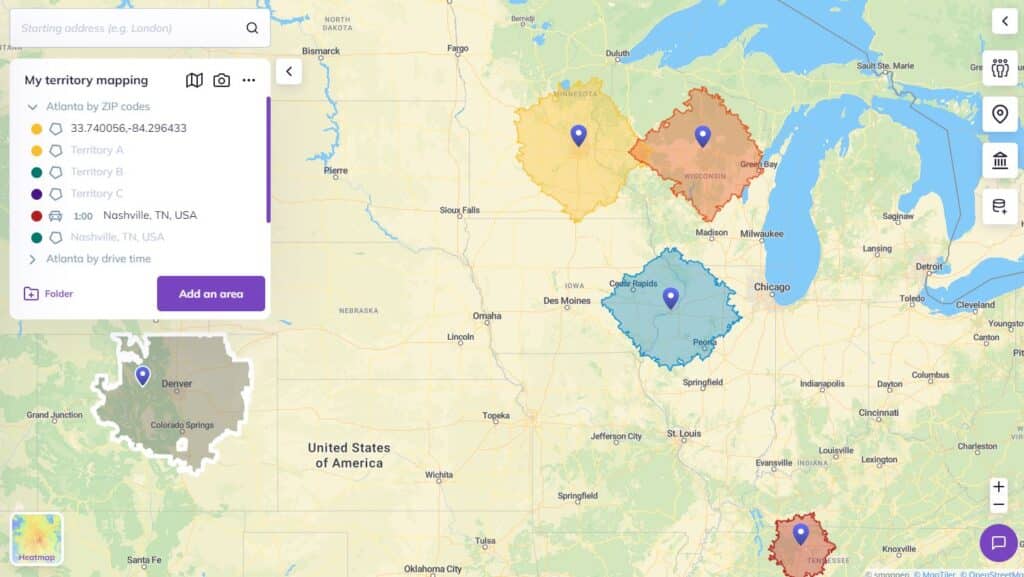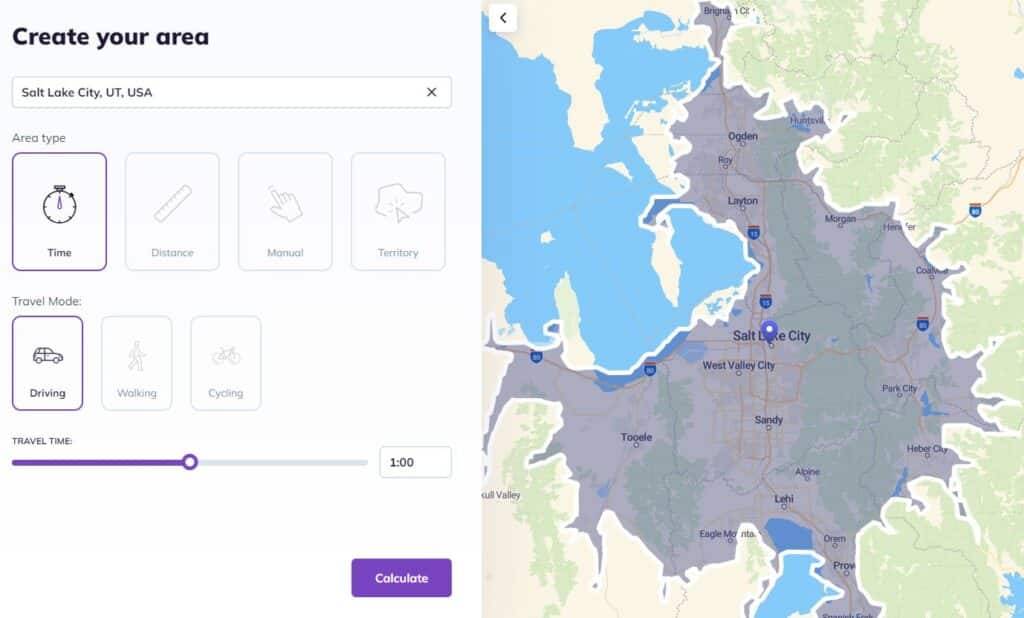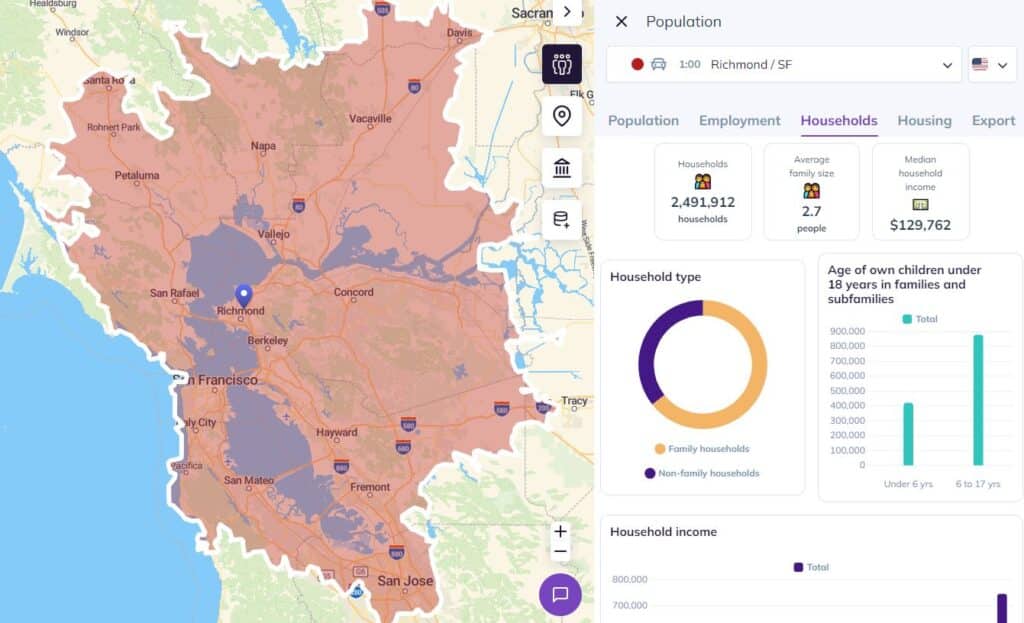Franchising isn’t just about spreading your brand’s wings; it’s about charting a course that doesn’t lead to a crash landing.
And guess what?
The world of franchise territory design is littered with pitfalls that can turn your business dream into a logistical nightmare.
Let’s dive into the nitty-gritty of territory design, but let’s keep it light – nobody needs extra yawns today!
1. Ignoring existing locations
Picture this: opening a new ice cream shop directly opposite your already popular sundae spot. Sounds unwise, right? That’s exactly the mistake many franchisors make – ignoring their existing network.
This oversight can lead to cannibalization, where new locations eat into the profits of existing ones.
The key here is to map your locations’ customer databases. This analysis can reveal potential risks and ensure your new franchise doesn’t inadvertently compete with an established one. It’s about harmony, not competition, within your brand.
💡 How to avoid this?
Avoiding overlap with existing locations when designing franchise territories requires a strategic approach. Here’s some tips to help you navigate this process effectively:
1. Map out existing locations
Use a mapping solution to create a visual representation of your current franchises with their actual influence area. You’ll get a great vision about cannibalization risks.

2. Analyze customer base and market penetration
Examine the customer base of each existing location. Understand where your customers are coming from and their buying behaviors. Assess the market saturation in these areas.
Identify if there’s still room for growth or if the market is already fully tapped.
2. Not taking ground reality into account
Aligning your territories with local geography, habits, and operational constraints is crucial. For instance, natural barriers like rivers or mountains should be taken into account.
Your goal is to make territories not just theoretically sensible but practically serviceable and accessible. It’s about working with the landscape, not against it.
💡 How to avoid this?
Here’s how you can ensure that your territories align with the practical realities of geography, local habits, and operational constraints:
1. Conduct thorough geographic analysis
Understand the physical layout of the area, including natural barriers like rivers, mountains, and large parks. Look for major roads, highways, and public transportation routes that impact how easily a location can be accessed.

2. Understand local market habits and preferences
Conduct local market research to understand consumer behavior in different areas. Be mindful of local customs, traditions, and lifestyles that might influence business operations. Talk to local business owners and community leaders to gain insights into the area’s nuances. Understand any local government regulations or zoning laws that might affect business operations.
3. Evaluate operational constraints
Assess the availability and quality of infrastructure like roads, and utilities. Consider the ease of supply chain management, including the delivery of goods and services to and from the location.
3. Not considering channel conflicts
In the age of clicking and mortar (see what we did there?), forgetting about your other sales channels can lead to a plot twist you didn’t see coming.
If your online store is undercutting your physical franchise, or if your product is easier to find at a local retailer, you’ve got a channel conflict. And trust me, that’s one drama you don’t want to star in. It’s about making all your sales avenues play nice together.
💡 How to avoid this?
Here are some tips!
1. Develop a comprehensive channel strategy
Craft a strategy that considers all channels – online, physical stores, and third-party retailers. Ensure they complement rather than compete with each other.
2. Price consistency across channels
This prevents undercutting and ensures customers don’t favor one channel over another due to price differences.
3. Leverage technology for inventory and sales management
Use technology to manage inventory across all channels. This helps in maintaining stock levels and prevents over-selling or stock-outs in any one channel.
4. Compromising future growth for immediate gains
Here’s a tricky one: you want to seal a deal now, but at what cost to future opportunities? It’s a bit like playing chess and thinking several moves ahead. Avoid expanding a territory so much that it stifles the potential for nearby future franchises. Short-term gains shouldn’t overshadow long-term strategy.
💡 How to avoid this?
Avoiding the trap of compromising future growth for immediate gains, especially in the context of franchise territory planning, requires a strategic and forward-thinking approach.
Develop a long-term strategy
Create a comprehensive plan that outlines your long-term vision for growth and expansion. This should include potential markets for future development. Use data and market analysis to forecast potential growth areas. This helps in identifying regions that may be more profitable in the long run.
Evaluate each deal carefully
Assess the impact of each potential deal on future expansion plans. Consider how granting a large territory to one franchisee might limit opportunities to open other profitable locations nearby. Always weigh the opportunity cost. What might you be giving up in the long term for a quick gain now?
Set clear territory boundaries
Establish clear and well-defined territorial boundaries that allow for future growth and expansion within and around existing franchises. Consider incorporating flexibility into your franchise agreements to allow for adjustments as your network grows.
5. Giving away market potential to close deals
Everyone loves a good bargain, but in the world of franchising, giving away too much can backfire. If you’re offering a particularly lucrative territory, make sure you’re getting something equally valuable in return. It’s about striking a balance between generosity and business savvy.
💡 How to avoid this?
Follow our tips
Valuate territories accurately
Conduct thorough research to understand the true value of each territory. Consider factors like population density, economic indicators, and competitive landscape. Be fully aware of what each territory has to offer a potential franchisee.
Set clear financial expectations
Strive for agreements where both parties feel they are getting a fair deal. This might include negotiations on initial fees, royalties, or support provided.
Maintain consistency in deal-making
Develop a standardized process for evaluating and closing deals to ensure fairness and consistency across all franchisees.

6. Creating unbalanced territories
Creating territories is a bit like slicing a cake – everyone wants a fair piece.
If you make one territory the size of Texas and another the size of Rhode Island, you’re asking for trouble.
Aim for balance, giving each franchisee a fair shot at success. Remember, unbalanced territories can lead to grudges, and before you know it, you’re in the middle of a franchise feud. And unlike reality TV, this kind of drama is bad for business.
💡 How to avoid this?
Use data-driving territory mapping
Understand the demographics, economic state to gauge market saturation and opportunities. Balance the size of territories with their market potential. A smaller area with high potential can be as valuable as a larger area with moderate potential.
Establish clear criteria for territory size
Develop a set of standardized metrics to determine the size and boundaries of each territory. This might include population size, number of households, or specific economic indicators.
Transparent communication with franchisees
Clearly communicate to potential and existing franchisees how territories are determined and why they are structured a certain way. Be open to feedback and willing to make adjustments if valid points are raised.
Regularly review and adjust territories
Be prepared to adjust territories based on market changes, economic shifts, and franchisee performance. Regularly evaluate the performance of territories and make data-driven adjustments as needed.
The quest for perfection: spoiler alert, it doesn't exist!
Trying to cover every inch of your target country is like trying to please everyone at a party – impossible. Some areas just aren’t worth the investment.
So, don’t stress about achieving 100% coverage. Focus on the areas that make sense for your business, and remember, sometimes it’s okay to leave a few blank spots on the map. After all, even Swiss cheese has holes, and it’s still delicious.
💡 How to avoid this?
Avoiding the pursuit of perfection in franchise territory planning, particularly the unrealistic goal of achieving 100% market coverage, involves a pragmatic approach.
Keep in mind:
- Embrace quality over quantity
- Set realistic goals for market coverage and concentrate on ROI
- Prioritize high-potential areas before considering less lucrative markets
- Understand local market dynamics and be prepared to adapt your business model to fit local market needs
- Leave room for future growth and be ready to seize opportunities in new areas when they become viable
- Use data-driven decision making and learn from both successes and setbacks in different markets to refine your expansion strategy
- Acknowledge and embrace imperfections!
And there you have it – a somewhat playful, yet thoroughly professional guide to avoiding the pitfalls of franchise territory design. With a bit of foresight and planning, you can navigate this complex process with confidence and maybe even a smile. Good luck, and may your franchise territories be ever prosperous! 🌟🗺️

